Exploring the Symbolism of the UAE Flag Colors
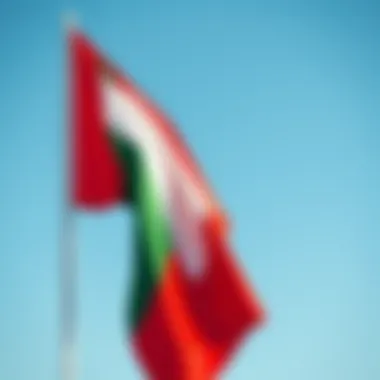
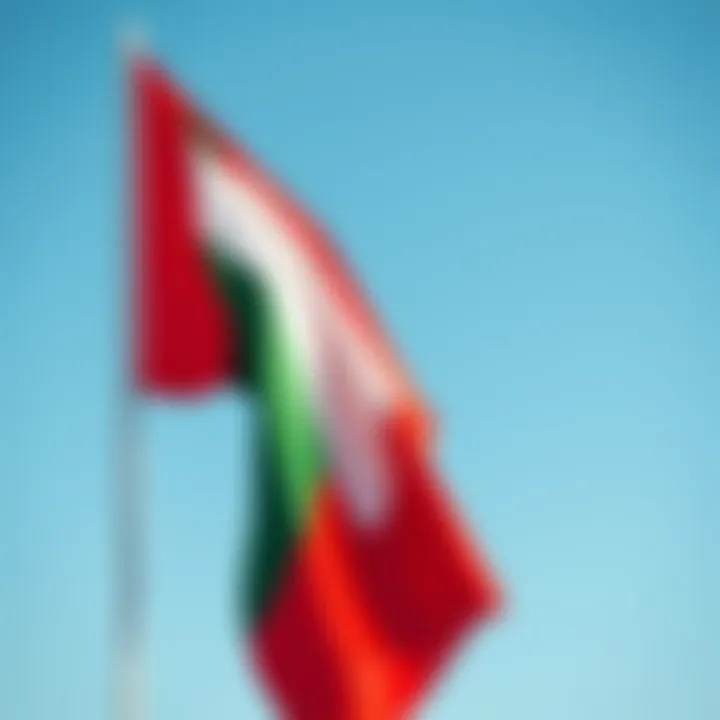
Intro
The flag of the United Arab Emirates paints a vivid picture, both in its colors and what they stand for. Each hue serves not only as a visual marker but also as a reflection of the values that bind the nation's people together. By exploring the emotive landscape of these colors, we gain insights into the unique identity of the UAE—a tapestry woven from tradition, aspirations, and a shared heritage.
In this article, we will unpack the significance behind the bold reds, greens, whites, and blacks of the UAE flag. Each shade carries its own meaning, rooted deeply in history and culture, encapsulating the essence of what it means to be Emirati.
Through a detailed examination, we aim to shed light on how these colors symbolize unity, strength, and diversity. For investors, expatriates, and anyone with a keen interest in the UAE's identity, understanding these elements is crucial. They form an essential part of the country’s narrative, connecting the past with the aspirations for future growth and prosperity.
As we navigate through this exploration, consider how each color resonates with the values of your own experiences or professional endeavors in the region. The connection between heritage and modernity is a powerful one and can echo in the hearts of all who are part of or connected to the UAE.
By engaging more deeply with the colors of the flag, we can appreciate the broader implications of these symbols in shaping the lives and identities of those who live and work within the UAE.
Stay with us as we delve into this fascinating world, uncovering the layers of meaning present in the UAE flag, starting with the ever-relevant market trends.
Preamble to the UAE Flag
The flag of the United Arab Emirates is not just a piece of cloth; it is a tapestry woven with the threads of the nation’s identity, culture, and aspiration. In this article, we journey through the significance of its colors, each carrying its unique weight and meaning. Understanding the importance of the UAE flag goes beyond its visual appeal; it’s about grasping the collective consciousness of a nation that celebrates unity and diversity.
Historical Context
The origins of the UAE flag can be traced back to the founding of the UAE in December 1971. The country emerged from a union of seven emirates, each bringing its own rich heritage. The flag embodies this unification, representing not only the individual emirates but also their collective future. It was chosen to reflect the values that the nation holds dear, with a design grounded in the cultural tapestry of the Arab world.
Historically, flags have served as symbols of power, pride, and people. For the UAE, the flag represents progress and harmony, illustrating the significant transformations that the country has undergone since its establishment. In looking back, we gain insights into the present identity of the UAE, an identity shaped by centuries of history but crystallized in the vibrant colors of its flag.
Design and Structure
The design of the UAE flag features a unique horizontal tricolor of red, green, and black, with a vertical white band on the hoist side. Each aspect of its design serves a purpose, reflecting cultural significances that are deeply rooted in the Arab world.
- Colors: The colors of the flag are not randomly chosen; each one has a specific meaning that resonates with the values and traditions of the UAE.
- Proportions: The proportions of the flag emphasize balance among the colors, mirroring the harmony that the UAE strives for within its diverse society.
"The flag is a symbol of unity, strength, and the shared aspirations of a diverse nation."
The layout itself highlights solidarity among the emirates. The vertical band of white denotes peace and honesty, while the horizontal arrangement of green, black, and red embodies themes of courage, resilience, and sacrifice. Thus, the design of the UAE flag is not merely a combination of colors; it represents the ethos of a nation that stands together despite its varied traditions and histories.
As we dive deeper into the specific meanings behind each color in the following sections, it becomes increasingly evident how the flag serves as a reflection of the UAE’s cultural landscape, aspirations, and values.
Colors of the UAE Flag
The colors of the UAE flag are more than just a visual identifier. They embody the spirit, aspirations, and history of the nation. Each hue has a story to tell, reflecting the shared values and identity of its people. Understanding these colors provides insight into what the UAE stands for and how its culture has evolved over time. This exploration lays the groundwork for deeper appreciation of national pride and unity amidst diversity.
Red Color
Symbolism of Courage and Valor
The red in the UAE flag carries significant weight, representing courage and valor. This color stands as a bold reflection of the nation's readiness to defend its integrity and sovereignty. It's a color that commands respect and serves as a powerful reminder of the sacrifices made by countless individuals throughout history. Such representation ensures that the theme of bravery resonates deeply within both the local populace and international observers.
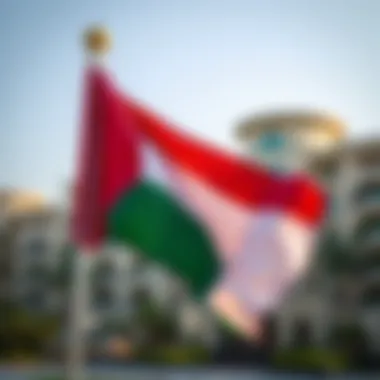
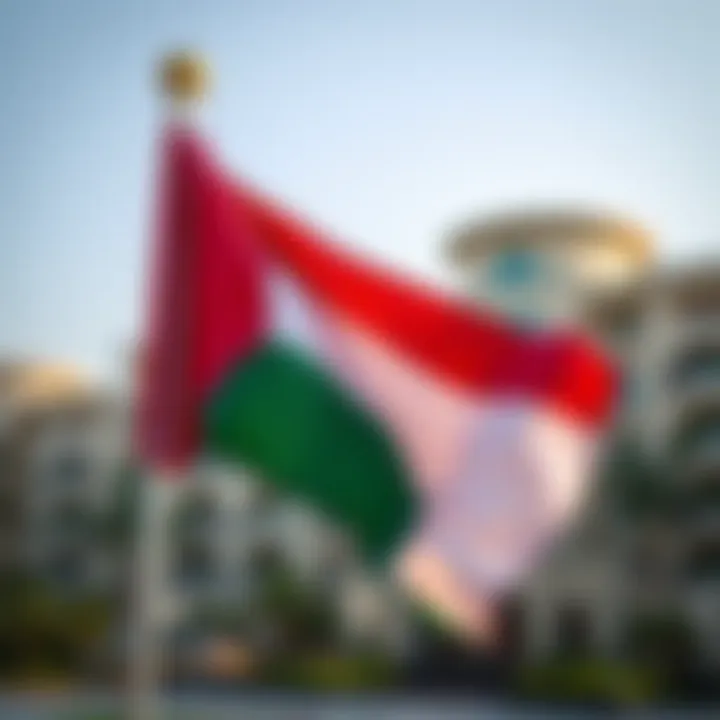
Historical Significance
Historically, red has been associated with leadership and sacrifice in many cultures, and the UAE is no exception. The use of red can be traced back through centuries of Arab history, symbolizing the blood shed in wars fought for honor and freedom. This historical context enriches the understanding of the flag’s design and its enduring significance, establishing red not just as a color, but as an emblem of national identity forged through struggle.
Cultural Reflections
In the cultural landscape of the UAE, red serves as a beacon of energy and passion. It finds expression not only in the flag but also in art, festivals, and traditional attire. The vibrant shade often signifies communal gatherings and celebrations, stirring a sense of togetherness among the Emiratis. This dual role of the color enhances its importance, showcasing both its heritage and its relevance in everyday life.
Green Color
Association with Prosperity
The presence of green in the flag symbolizes a strong link to prosperity and growth. In the context of the UAE, it reflects the nation's ambitions for a verdant future filled with opportunities. This hue resonates well with the flourishing economy and the global aspiration of the Emirates to promote sustainable development and environmental stewardship.
Natural Heritage
Green is also deeply rooted in the natural landscape of the UAE, from the lush palm groves to sprawling parks in urban areas. This connection to nature emphasizes a commitment to preserving the environment while cherishing the landscapes that define the country's geography. It showcases the Emirati appreciation for biodiversity and the vital balance between urbanization and nature.
Islamic Influence
Moreover, green holds a special status in Islamic tradition, often regarded as a color of paradise and spirituality. It is prevalent in various Islamic art forms and architecture throughout the Emirates. This spiritual connotation enriches the meaning behind the green in the flag, linking it to a broader cultural narrative that transcends borders, reaffirming shared beliefs within the Arab and Islamic communities.
White Color
Representation of Peace and Honesty
The white stripe in the UAE flag stands for peace and honesty. It encapsulates the nation’s desire for tranquility, both within its borders and in its foreign relations. This pursuit of peace is particularly relevant in today's interconnected world, where the UAE plays a crucial role in diplomatic efforts across the Middle East and beyond.
Social Values
White also embodies social values such as integrity and transparency, which are foundational pillars for the UAE's governance and community interactions. The essence of these qualities is reflected in everyday life, promoting a culture based on mutual respect and understanding. This emphasis on social values enhances the country's image as a progressive nation keen on collaboration and dialogue.
Cultural Interpretations
Culturally, white is celebrated in various Emirati traditions, symbolizing new beginnings and optimism. It is a common choice for traditional attire during significant events and celebrations, further interweaving the color into the fabric of Emirati society. This dual aspect of cultural relevance and national pride contributes to a well-rounded understanding of the flag’s message.
Black Color
Embodiment of Strength and Resilience
The black in the UAE flag embodies strength and resilience, showcasing the unwavering spirit of the Emirati people. This characteristic serves as a reminder of the nation’s ability to withstand challenges and pursue growth despite adversities. The strength represented by this color plays a crucial role in fostering national pride and unity.
Historical Context
Historically, black has been a symbol associated with authority and governance in Arab culture. Its significance is evident in traditional garments and artifacts, linking the color to a rich heritage of leadership that has shaped the UAE’s past. This historical lens offers a deeper appreciation of the flag's components, reminding viewers that strength is often born from adversity.
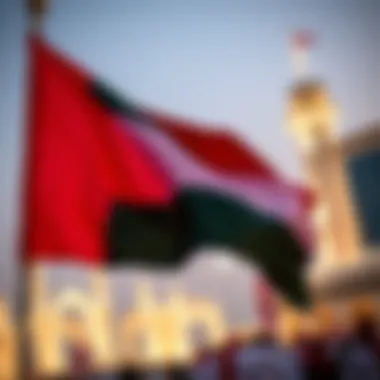
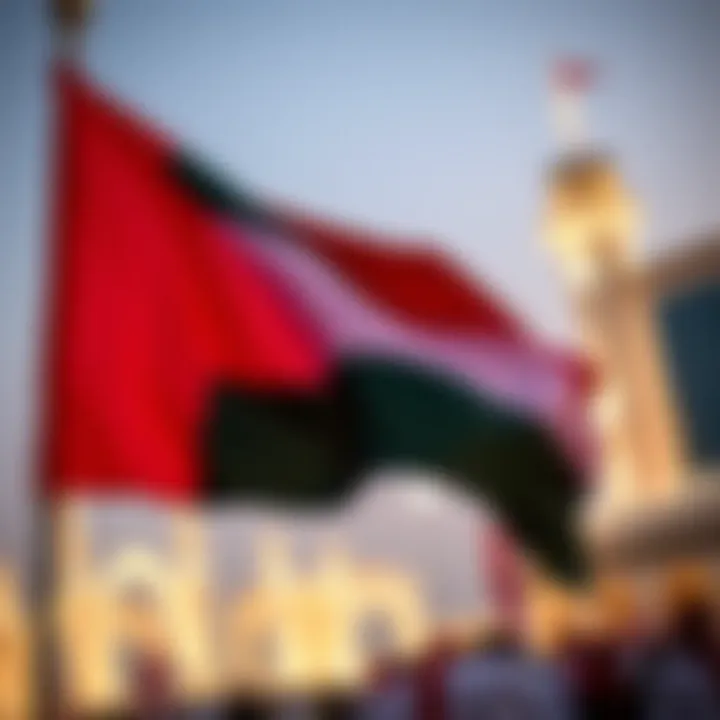
Modern Perceptions
In contemporary society, black is often seen as a color of sophistication and modernity. As the UAE positions itself internationally, black serves as a symbol of innovation and ambition in a rapidly changing global landscape. Such perceptions contribute to the narrative of the UAE as a forward-thinking nation while honoring its deep-rooted traditions.
Symbolism Beyond Colors
The colors of the UAE flag are not mere decorations; they represent a deeper, more intricate tapestry of the nation’s identity. Each hue signifies aspects that are essential to understanding what binds the people of the UAE together. This section explores themes of unity, cultural heritage, and societal values, showcasing how these dimensions enrich the significance of the colors beyond their visual appeal.
Unity of the Emirates
The colors of the UAE flag—red, green, white, and black—serve as a powerful symbol of unity among the seven emirates. They remind the citizens and residents of how different regions can coalesce into a single national identity. This unity is crucial, especially considering the diverse cultural backgrounds present in the UAE, where you can find a rich blend of traditions and customs from all over the globe.
- Historical Context: The unification of the emirates in 1971 marked a new era for the country. This unity is symbolized through the flag's colors, which represent a collective spirit among the emirates, reinforcing the notion that together, they are stronger than the sum of their parts.
- Modern Interpretations: In today’s fast-paced world, where globalization often seems to dilute local identities, the colors remind citizens of their roots. Unity is celebrated during events like the UAE National Day, where the flag is flown high, instilling pride and a sense of belonging.
Cultural Heritage
Cultural heritage in the UAE is intricate, rooted in centuries-old traditions and practices. Within the context of the flag's colors, each shade draws connections to historical narratives and milestones that have shaped the nation’s identity.
- Preserving Traditions: The colors convey not just a sense of belonging, but also narrate a story. For instance, during traditional gatherings or festivals, communities come together under the flag, fostering appreciation of their shared history and values. They serve as a reminder of the importance of cultural preservation in a nation that thrives on a melting pot of cultures.
- Artistic Expressions: Beyond the flag itself, the colors are prominently featured in various forms of art, literature, and music that celebrate Emirati culture. Artists in the UAE often incorporate these colors into their works, using them as canvases to tell the story of resilience and hope.
Societal Values
The societal values of the UAE are embedded within the interpretations of the flag's colors, underpinned by a shared commitment to principles like tolerance, generosity, and respect.
- Symbol of Peace and Cooperation: The white color in the flag signifies peace and the values of honesty which the Emirati people hold dear. It embodies the notion that harmony and coexistence are achievable, even amidst diversity.
- Collective Responsibility: Moreover, colors serve as a constant reminder of the responsibility of each citizen and resident to contribute positively to the community. Acts of charity and community service are often highlighted during national celebrations, reinforcing the notion that everyone is a custodian of the UAE’s values.
"The colors of the UAE flag are a reflection of the commitment to unity and shared cultural values that bind its citizens and residents together."
In summary, the significance of the colors extends far beyond their aesthetic qualities, they encapsulate collective aspirations and cultural identities. Understanding how these colors symbolize unity, heritage, and values not only enriches one’s perspective of the UAE but also emphasizes the importance of embracing diversity within a cohesive national framework.
Historical Evolution of the Flag
The evolution of the UAE flag tells a compelling story of the nation’s journey towards unity and identity. Understanding this historical context is crucial, not just for the sake of patriotism, but for appreciating how far the UAE has come as a collective society. The flag, a symbol of pride and national spirit, has undergone transformations that mirror the aspirations and struggles of its people.
Flag Before Unification
Before the seven emirates united in 1971, flags varied widely across the regions, each representing the individual emirate’s identity and its unique heritage. The flags showcased specific symbols or colors that resonated with local history and culture. For instance, the flag of Abu Dhabi featured a sun and palm tree, while other emirates might have opted for different motifs like the falcon, a powerful symbol in Arab culture.
Each flag carried profound meanings rooted in the local traditions and narratives, which emphasized regional pride. However, these disparate representations made it somewhat complicated to forge a coherent national identity. The fragmentation in flag designs mirrored the political landscape of the time, each emirate largely focusing inward, which didn't contribute to a unifying national sentiment.
As the nation sought unity, discussions arose about a flag that could represent all emirates and encapsulate their shared values and aspirations.
Flag After Unification
With the unification of the UAE in December 1971, a need emerged for a single flag that could stand for the new federation. The current flag design was raised for the first time on December 2, 1971, a day now celebrated as the UAE's National Day.
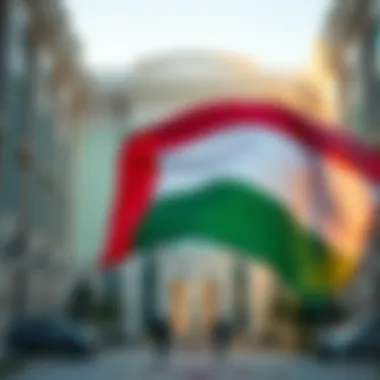
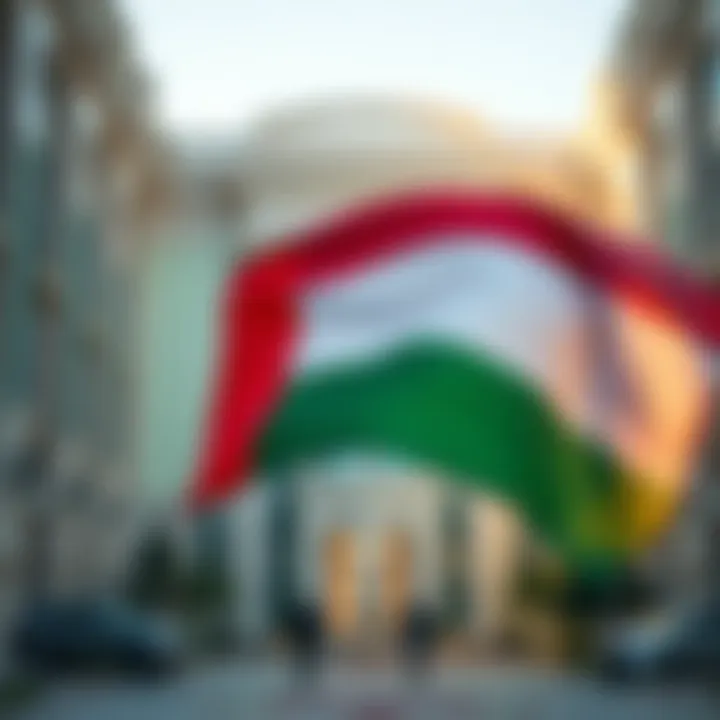
The flag’s design incorporates four colors: red, green, white, and black, each with its own meaningful symbolism.
- Red Color: Represents courage and valor, reflecting the blood of those who fought for the nation’s unity.
- Green Color: Symbolizes growth and prosperity, a nod towards the rich flora of the land and a hopeful future.
- White Color: Stands for peace and honesty, embodying the desire for harmony within the nation and beyond.
- Black Color: Embodies strength and resilience, signifying the determination of the UAE’s citizens to thrive.
This flag effectively bridged the gap between the individual emirates' legacies and the new national identity they were crafting together. It represented not just a visual emblem but also a commitment to unity, progress, and shared prosperity.
"The UAE flag is more than just cloth; it’s a representation of our past, our unity, and our aspirations for a brighter future."
Through the decades, the flag has evolved in its significance from a mere identifier of separate states to a powerful symbol of a cohesive nation that embraces diversity. It has taken center stage in national celebrations, educational campaigns, and public displays, showcasing a collective commitment to its values.
As the country continues to grow, so too does the importance of the flag in shaping national consciousness and fostering a sense of belonging among its residents—be they citizens or expatriates. Thus, understanding the silk thread of history woven into the fabric of the UAE flag elevates not just national pride but also a deeper understanding of the united UAE and its cultural richness.
The Flag in Contemporary Society
The United Arab Emirates flag, beyond its historical roots, plays a pivotal role in contemporary society. It embodies the spirit and aspirations of the nation, serving as a symbol in various public and private spaces. In modern times, the flag’s significance is multi-faceted, encompassing elements of national pride, unity, and cultural identity.
Public Displays and Celebrations
In the UAE, the flag is prominently displayed during national celebrations, including Union Day and Flag Day. During these events, citizens and expatriates alike gather, proudly waving the flag in parades and festivities. These displays aren't just about honoring the flag; they represent a collective sentiment of belonging and shared heritage. Every flutter of the flag in the wind reverberates with sentimental value, particularly in a nation characterized by its diverse population, where various cultures blend into a singular narrative.
One can observe how governmental buildings, schools, and even private homes are often adorned with the national colors during these occasions. This isn’t merely a decorative practice; it's a reinforcement of national identity. In homes across the UAE, children learn the flag’s meaning alongside the national anthem, embedding a sense of pride from an early age.
Community events inspire camaraderie as people from different backgrounds unite under the common banner. For instance, one recent Flag Day saw a magnificent display of cultural performances, showcasing how engrained the flag is in the social fabric of the country. The colors paint a vivid picture of courage, peace, and resilience, reminding everyone of the shared ideals that the Emirates stand for.
Educational Campaigns
Education serves as a cornerstone in understanding the significance of the flag. Many schools in the UAE run educational campaigns focused on the meanings behind the colors of the flag. These initiatives aim to instill respect and appreciation among students for their national symbols.
Such campaigns take on various forms—lectures, workshops, and creative projects where children design their own interpretations of the flag. Theoretical knowledge transitions into practical understanding as students engage in discussions about the historical context and the values each color signifies. This engagement nurtures critical thinking, ensuring that the importance of the flag extends beyond mere aesthetics to a deeper understanding of national unity and identity.
Educational institutions also collaborate with local governments to organize field trips and interactive events centered on the flag’s history. These experiences reinforce the idea that the flag is not just a piece of fabric, but rather a symbol of collective aspirations, with roots deeply embedded in the UAE's rich history. In reinforcing the colors and their significance, the educational campaigns cultivate a sense of responsibility among the younger generation, encouraging them to carry forward the legacy of pride in their national identity.
"The flag unites us; it's a reminder of our common purpose and the remarkable journey we've embarked upon as a nation."
Epilogue
The exploration of the UAE flag's colors reveals much more than just a visual composition; it is a powerful embodiment of the nation’s identity, aspirations, and values. Each hue is interwoven with meanings that reflect a rich historical context and cultural significance. This article underscores the importance of understanding these colors as they serve to unite the diverse populace of the UAE.
Reflection on UAE Identity
In this regard, the colors of the flag are not mere decorations but rather symbols of unity and resilience among the emirates. The red signifies courage, a trait inherent in the heart of every Emirati. Green, on the other hand, embodies prosperity and hope for a fruitful future, as well as the natural beauty found within the region’s landscapes.
White stands as a testament to the peace and harmony that the UAE strives for, distinguishing the nation in a complex geopolitical landscape. Meanwhile, black acts as a reminder of strength and the challenges overcome throughout the country’s evolution.
When these colors come together, they tell a story that transcends mere representation. They are a visual narrative of the UAE’s journey; from its modest beginnings to its current status as a thriving hub for business and culture.
The collective identity portrayed through the UAE flag instills pride not just in residents but also in expatriates and investors as they each find their place within this multifaceted society. As the UAE continues to evolve, its flag serves as a constant reminder of the nation’s foundational principles and enduring spirit.
Through understanding these colors, readers gain insight into how national identity is shaped—highlighting the threads of shared heritage and the ongoing endeavor for growth and unity. This comprehensive examination can enrich the perspectives of those engaged in or interested in the UAE's dynamic landscape.
For further insights on the significance behind national symbols, explore resources such as Britannica or delve into community discussions on Reddit.
In summation, recognizing the full meaning behind the UAE flag's colors fosters a deeper connection with the nation's ethos and reinforces the understanding of what it means to be part of the UAE's diverse and vibrant community.



